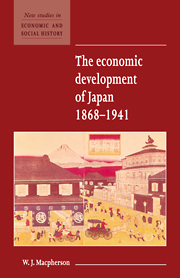Book contents
- Frontmatter
- Contents
- List of tables
- Notes on references
- Preface
- 1 Introduction
- 2 Growth and structural change
- 3 The Tokugawa background (c. 1600–1860)
- 4 The role of the state
- 5 Factors in demand
- 6 Land and agriculture
- 7 Labour supply and the labour market
- 8 Capital, technology and enterprise
- 9 Conclusion
- Bibliography
- Bibliographical update
- Updated bibliography
- Index
- New Studies in Economic and Social History
6 - Land and agriculture
Published online by Cambridge University Press: 11 January 2010
- Frontmatter
- Contents
- List of tables
- Notes on references
- Preface
- 1 Introduction
- 2 Growth and structural change
- 3 The Tokugawa background (c. 1600–1860)
- 4 The role of the state
- 5 Factors in demand
- 6 Land and agriculture
- 7 Labour supply and the labour market
- 8 Capital, technology and enterprise
- 9 Conclusion
- Bibliography
- Bibliographical update
- Updated bibliography
- Index
- New Studies in Economic and Social History
Summary
Many economic historians find the main explanation of Japanese expansion in the supply side of the economy. In the remaining sections we consider the factors of production, land, labour, capital, technology and enterprise.
Japan demonstrates that a poor resource base and scarce cultivable land are not insuperable obstacles to development. She was deficient in industrial raw materials, particularly iron ore. The percentage of raw materials in imports had to rise from 8 in 1874–83, to over 40 in the 1930s and to a peak of 63 per cent in the late 1950s. Some 65 per cent of Japan is under forests. These were an important source of employment and income for peasants; raw silk depended on mulberry trees and timber was used in a variety of modern and traditional industries, including building, furniture and paper. Marine products provide up to half of the animal protein in the Japanese diet, and were significant in exports and a valuable source of fertilisers.
Agriculture's share of net domestic product in current prices fell from over 42 per cent in the late 1880s to 18 per cent in the late 1930s and to around 8 per cent in 1970. The ratio of primary to total labour force fell from 75 per cent in 1880 to 43 per cent in 1940 and 20 per cent in 1970. Output data have been the subject of frequent revisions, notably by Nakamura.
- Type
- Chapter
- Information
- The Economic Development of Japan 1868–1941 , pp. 46 - 55Publisher: Cambridge University PressPrint publication year: 1995

